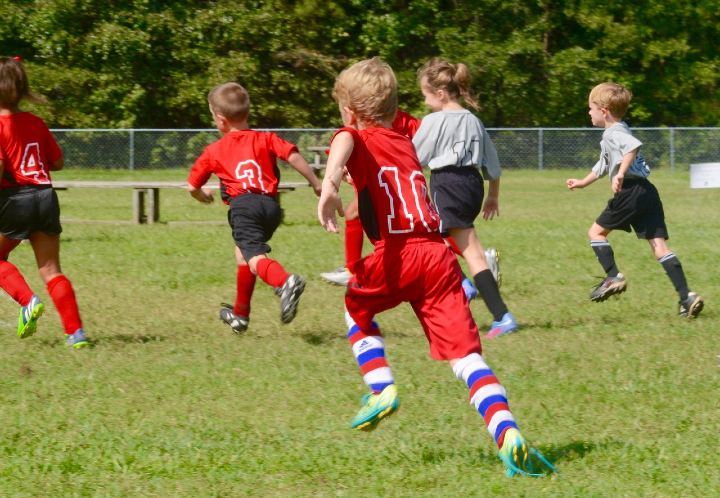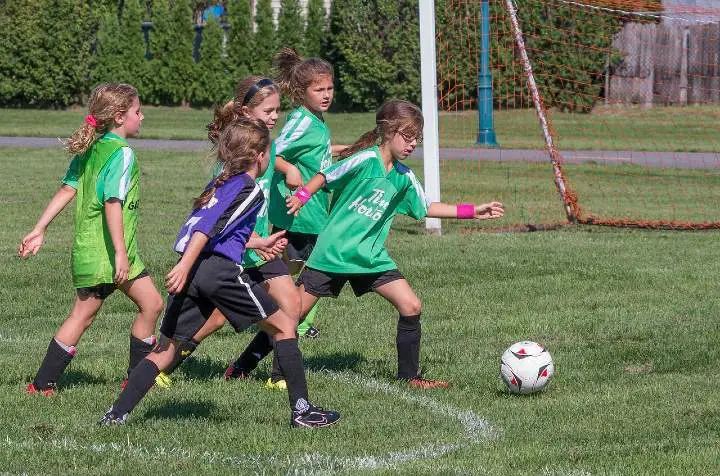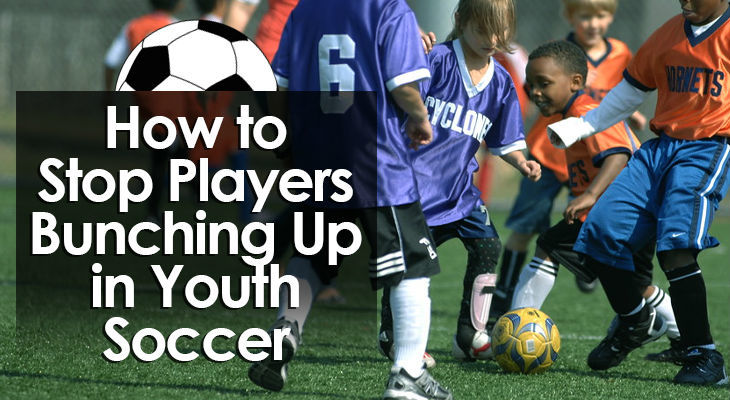How to Stop Players Bunching Up in Youth Soccer
One of the most frustrating parts of coaching young soccer teams is watching everyone chase the ball in one pack.
Everyone’s focused on winning the ball back and giving it a good kick — hopefully in the direction of the correct goal!
At an early age, this bunching is only natural, and it’s something you’ll continue to see until they learn how to spread out and play as a team.
While this joyful enthusiasm to kick and follow the ball is as commendable as it is comedic, it can be infuriating to watch as a coach!
So...
- Why exactly do young players bunch up?
- What can you do to prevent it?
- And are there any benefits from this intense swarming approach?
I’ll answer all these questions (and more) below:
Why Do Kids Bunch Up?
Bunching up is a natural instinct that young players have when competing at the earliest age groups, and there might not be much you can do about it.
At that early age, players just want to kick the ball as much as possible.
No matter how much you explain to them why they shouldn't rush after it, I guarantee they’ll forget as soon as they take the pitch and the match begins.
This is because they are very much still in a “me” stage of development where everything revolves them.
It’s nearly impossible to get them to understand the concept of a team and the importance of working together, especially when some of them probably wouldn’t even be able to spell “teamwork” yet!
You can certainly try your utmost to teach them not to bunch up (and there are a few different drills you can run to encourage them to spread out and keep their positions) but there are thankfully some benefits of bunching up at that early age too.
The Benefits of Bunching Up
While it may look like a mad, chaotic scramble with all the players frenetically kicking away at the ball, youngsters do actually derive some benefits from bunching up.
Throwing themselves into heat of battle, young players learn to lose their fear of getting tackled and this stands them in good stead for when they're older.
Getting used to the physical side of the game is arguably more important than learning positions or tactics at that early age, so it could be argued that you're better off leaving them to bunch up rather than spread out.
The other bonus of bunching up is that players learn to play in small spaces and this helps improve their technique and footwork.
With so many players around them (both teammates and opponents), the youngsters have to try and control the ball, shield it, and manoeuvre it into space before giving it a good kick.
Learning how to do this at a young age will again help them to thrive when they have more space to operate in when they're older.
With that said...
It’s definitely worth working on drills which encourage players to spread out, keep their positions, and not bunch together.
Once they get to an age where they understand what you're asking of them, then you'll quickly see improvements and after the many seasons of watching them bunch together, you'll be ecstatic at seeing them spread out before you on the pitch in what looks like a formation!

Drills to Stop Players Bunching Up
It is important to bear in mind that no matter how many times you go over drills to stop players bunching up, when it comes to game time, youngsters are liable to immediately forget everything you've told them.
Unfortunately shouting instructions from the sidelines doesn't help either as in their excitement the players simply want to chase and kick the ball.
In this case, time and maturity is what will eventually see your players stick to their positions and use all of the space on the pitch.
So, please don’t beat yourself up if you see your players seemingly forget everything you've gone over in your previous training sessions!
But this doesn’t mean you shouldn’t try to stop them bunching up, as you’ll undoubtedly see the benefits of all this hard work one day.
Here are some drills you can try out to encourage players to keep their distance from each other.
The key, as with most soccer drills, is repetition so it is well worth running these drills a number of times.
Drill Number One:
Set up a line of cones down the centre of the pitch – players on one side are not allowed to cross over into the other when they're attacking. Just by providing this visual barrier you can encourage players to stay on their side of the pitch.
Drill Number Two:
Set up two lines of cones so that the pitch is divided into thirds. This then encourages some players to stay in the middle and others to stay out wide to either side of them.
Drill Number Three:
Set up zones of cones which players aren't allowed to leave. By “cementing” them in place in their zone, you make sure that players have to pass the ball up the field if they are to advance and score a goal.
Drill Number Four:
Have the players line up in two lines parallel to each other. Throw the ball ahead of one player and once they reach it make sure they square it to the other player who can then take a shot at goal. By setting them up in two lines, you stop both players going for the ball at once and demonstrate how space can be used.
Drill Number Five:
One game you can play is to throw a player a ball to control it and get everyone around them to sprint away from the “grenade” as fast as they can until they pass it back to you and you start the game again. This then stops them from bunching up.
Drill Number Six:
Playing handball with the kids can often be a good way to get them to spread out and use the space. When one player has the ball in their hands, they are stuck and can't move and so have to throw the ball to one of their teammates. This then unsticks them and they can move into space again and ask for the ball back.
Drill Number Seven:
Another very simple drill is to simply ask them what they should do when their teammate has the ball and get them to chant “stay away!” back at you until it seems to have sunk in! You can then incorporate this into some of your other drills and at various times ask them during training what they should do if their teammate has the ball.

Should You Stop Your Players Bunching Up?
Now at that age there are a couple of possible issues with trying to stop your players from bunching up besides them immediately forgetting what you've asked them to do!
For instance, some players may become so focused on keeping their position that they don't attempt to tackle another player if they're running past them or forget to get involved in the match when they have a chance.
In addition to this, they may not yet have the technical or physical capacity to actually take advantage of an open teammate, even if the players do manage to keep spread out.
As such, you could argue that it is more important, at this early stage, to focus on improving their key skills such as passing, dribbling, and ball control rather than stopping them from bunching up.
Conclusion:
While bunching up may be one of the most frustrating things in the world to watch as a coach, it surprisingly helps players to develop some key skills which will stand them in good stead later on in life.
Although soccer is obviously meant to be played on the whole pitch, at a young age many players just don’t have the physical, technical, or mental capacity to make the most of all of the space around them.
There will, however, come a time when they start to realise the benefits of spreading out and start to keep their positions out on the pitch.
As a coach, it is well worth trying to stop players bunching up (if possible!) although you may be better off saving yourself a whole lot of frustration and working on other key skills in the meantime.
With time, maturity, and some help from their coach, they will eventually stop bunching up and what a satisfying day that will be when it arrives!
Further Reading: How to Coach Soccer 101: 7 Rules for First-Time Coaches

